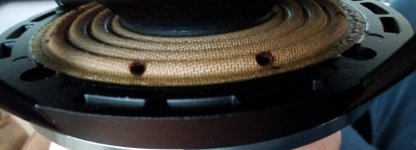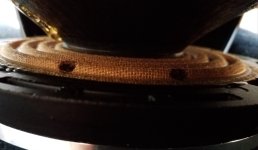After some research I went through trying to find suitable midbass drivers for my latest design, I started paying closer attention to the motor noise which affects some cone drivers under certain operating circumstances.
In the case of the B&C 8NDL51, which is one of my all time favorite midbass drivers, its typically not an issue when using it specifically as a midbass in a small sealed enclosure. The lack of pressure differential between the backside of the cone and internal space behind the spider cancels out most of the excursion noise. In free air, the motor is noisy due to increased air velocity across the VC gap. This is how B&C purposely designed the driver for sufficient VC cooling. It only becomes audible when there's a pressure differential across the spider surface. Even though the driver motor is dead quiet on the 8NDL51 in a smaller sealed box, I wanted to explore noise reduction options with it based on feedback from others having used various other pro audio drivers for critical applications.
Warning!!! Not responsible for damage to your driver if you attempt this modification !!!
The solution to a noisy motor on a cone midbass is usually straight forward and very simple. It involves a soldering iron and a steady hand. Just apply light pressure with a blunt tipped soldering iron onto the desired spot you wish to create a vent hole and let the heat of the iron do the rest. In most cases, 4 to 8 evenly spaced 3/16" holes are sufficient to quiet the driver down to the point the motor becomes silent. Using the soldering iron to burn in the vent holes avoids any debris from being generated and entering the VC gap. 700 degrees is the preferred starting point depending on spider material used along with any coatings and treatments. Most spiders require only this much heat to give way. Some silicone coated or nomex spiders may need more heat.
The goal here is to reduce airflow velocity across the restrictive vent holes and VC gap on most higher powered cone midbass drivers. This may have an impact on cooling at high power levels, but in most cases there have been no observed negative consequences to driver longevity or reliability. Perhaps under the most extreme operating conditions this may have an impact on cooling, but so far I haven't seen any issues on the countless drivers I've modified to reduce excursion noise. I do this to alot of drivers, but mainly only if they exhibit any noise and don't possess any pole piece venting or other means of ventilation. Doing this to a driver equipped with a phase plug is pointless for obvious reasons.
So if you have issues with a noisy motor on a cone driver, try this. It has never failed me to date, but as usual, YMMV.
In the case of the B&C 8NDL51, which is one of my all time favorite midbass drivers, its typically not an issue when using it specifically as a midbass in a small sealed enclosure. The lack of pressure differential between the backside of the cone and internal space behind the spider cancels out most of the excursion noise. In free air, the motor is noisy due to increased air velocity across the VC gap. This is how B&C purposely designed the driver for sufficient VC cooling. It only becomes audible when there's a pressure differential across the spider surface. Even though the driver motor is dead quiet on the 8NDL51 in a smaller sealed box, I wanted to explore noise reduction options with it based on feedback from others having used various other pro audio drivers for critical applications.
Warning!!! Not responsible for damage to your driver if you attempt this modification !!!
The solution to a noisy motor on a cone midbass is usually straight forward and very simple. It involves a soldering iron and a steady hand. Just apply light pressure with a blunt tipped soldering iron onto the desired spot you wish to create a vent hole and let the heat of the iron do the rest. In most cases, 4 to 8 evenly spaced 3/16" holes are sufficient to quiet the driver down to the point the motor becomes silent. Using the soldering iron to burn in the vent holes avoids any debris from being generated and entering the VC gap. 700 degrees is the preferred starting point depending on spider material used along with any coatings and treatments. Most spiders require only this much heat to give way. Some silicone coated or nomex spiders may need more heat.
The goal here is to reduce airflow velocity across the restrictive vent holes and VC gap on most higher powered cone midbass drivers. This may have an impact on cooling at high power levels, but in most cases there have been no observed negative consequences to driver longevity or reliability. Perhaps under the most extreme operating conditions this may have an impact on cooling, but so far I haven't seen any issues on the countless drivers I've modified to reduce excursion noise. I do this to alot of drivers, but mainly only if they exhibit any noise and don't possess any pole piece venting or other means of ventilation. Doing this to a driver equipped with a phase plug is pointless for obvious reasons.
So if you have issues with a noisy motor on a cone driver, try this. It has never failed me to date, but as usual, YMMV.

